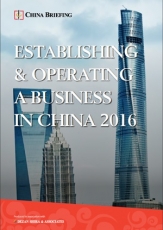Better Together: Assessing the Potential of Crowdfunding in China
By Zolzaya Erdenebileg
Crowdfunding, a method of funding a project or venture through donations via an online platform, has become a popular way to raise investments in the West. In China, however, it remains a relatively nascent industry. By the end of April 2016, there were a total of 332 crowdfunding platforms in China compared to 344 in the U.S. by the end of 2013.
However, China’s potential for growth in the industry is enormous. According to estimates by the World Bank in its 2013 Crowdfunding’s Potential for the Developing World report, China is estimated to generate US$50 billion, or 52 percent of the global total, in crowdfunding by 2025. During 2015, RMB 11.4 billion (US$1.7 billion) was raised through crowdfunding platforms in China – an increase of over 400 percent compared to 2014.
By the end of 2015, 283 crowdfunding platforms hosted 49,242 projects in China. The majority of these projects – 69 percent – were reward-based crowdfunding, where participants were given incentives in return for donations. About 15 percent was charity crowdfunding and about another 15 percent was equity crowdfunding, where participants were given equity shares in return for donations.
Market conditions
Crowdfunding first appeared in the Chinese market in July 2011, with the debut of Demohour, a platform primarily serving creative fields such as design, film and video, music, and publishing. At present, Demohour is one of the largest crowdfunding platforms in China. However, its specific focus on creative fields makes it difficult to compare with the traditional reward and equity crowdfunding platforms. Even Demohour’s founder and chief executive Chang Yu considers the company to be more of an online presale retailer, more akin to Groupon than to Kickstarter.
In fact, many crowdfunding platforms in China have specialized focuses. For example, Dreamore raises funds for art, culture, and public welfare projects, Musikid serves as a platform for music-related projects, and Tao Meng funds amateur filmmakers and can also recruit crew for proposed projects.
Additionally, Chinese crowdfunding platforms, more so than their counterparts in the West, offer more tangible rewards for their contributors. Chang of Demohour attributes this to the different culture of donations in mainland China. Frequently, a campaign will offer physical goods like coupons, souvenirs, books, and/or DVDs in return for the contributions – much more like a sale than a donation. In most cases, the idea or innovation that the campaign is raising funds for has already started or finished their first prototype.
![]() RELATED: Business Advisory Services from Dezan Shira & Associates
RELATED: Business Advisory Services from Dezan Shira & Associates
That is not to say that more conventional types of crowdfunding do not exist in China. AngelCrunch, which functions as an AngelList for Chinese companies, was one of the first and is currently one of the biggest equity crowdfunding platforms in China. The platform has 8,000 registered entrepreneurship projects, more than 1,000 listed companies, and over 22,000 members. Other well-known equity sites include Dajiatou, Yuanshihui, Renrentou, ihetou, Yunchou, and more.
Top players
At present, it seems that the crowdfunding industry will experience numerous and lasting changes as bigger companies foray into the field. In December 2013, Aliababa launched crowdfunding on Taobao, under which the company created Yulebao, which allows investors to support Chinese films. The site allows participants to invest small amounts, between RMB 100 and RMB 1,000, in domestically-produced films, and was involved in funding popular projects like “Wolf Totem” and “Tiny Times.”
In July 2014, JD.com, one of China’s largest e-commerce websites, launched Coufenzi, a crowdfunding platform hosting a variety of projects. Shortly after, in 2015, JD.com launched JD Equity Crowdfunding, a platform devoted to entrepreneurs looking for early-stage investors. Baidu and Tencent also entered the market by launching Baidu Crowdfunding and Tencent Succor, also known as Tengxun Lejuan.
Market potential
Recently, there have been many new entries into the market, not only because of the massive potential of Chinese crowdfunding, but due to the prevalence of smartphone usage among the Chinese populace. There are 650 million internet users in China, and 86 percent of internet usage is through smartphones. Furthermore, the use of electronic money is on the rise; Alipay consists of 350 million users, with WeChat Wallet, Baidu Wallet, and many others vying for market share.
There is also a need for crowdfunding from both the demand and the supply side. Chinese investors are actively on the hunt for attractive investment projects to place their money – about US$4.6 trillion worth. At the same time, startups and entrepreneurs have difficulties accessing loans, both from commercial banks and institutional investors, and a low percentage of all bank loans are directed towards them.
Regulating the market
Despite positive momentum within the market, crowdfunding in China has been rocked by allegations of fraud. One such example is Ezubao, an online finance company that supposedly offered fake investment products to nearly one million investors, pilfered over US$7.6 billion, and in late 2015, was eventually investigated, shut down, and discredited by local officials as a large Ponzi scheme. Cases like Ezubao highlight the need for oversight in what may one day be the world’s largest crowdfunding market.
 RELATED: Pre-Investment and Entry Strategy Advisory from Dezan Shira & Associates
RELATED: Pre-Investment and Entry Strategy Advisory from Dezan Shira & Associates
Industry regulations have been slow to be approved and implemented, and at times, contradictory. In December 2014, the Securities Association of China (SAC) issued the first draft regulations for equity crowdfunding, including clear rules on what platforms, investors, and companies are and are not allowed to do. Simultaneously, the draft regulations also place higher requirements for prospective investors, based on the idea that investors must be of the “accredited” sort. This would mean that anyone who wants to invest in equity crowdfunding projects must meet at least one of the following requirements:
- Investing at least RMB 1 million in a single project;
- Possessing net assets of RMB 10 million; or
- Possessing financial assets of RMB 3 million and having an annual income of at least RMB 500,000 for the past five years.
The draft is still under discussion; therefore, it is possible that further changes will be made. However, it is a telling sign of the confused regulatory state of the industry – the government wants to support it, but may pass laws restricting it and thus, stunt its growth.
More recently, in July 2015, China’s central bank and several other relevant government departments issued a guideline to regulate the general online finance industry. In August 2015, the China Securities Regulatory Commission (CSRC), the supervising government body for crowdfunding, announced that it would begin inspecting online equity financing platforms and assessing any possible illegal activities. In December 2015, the China Banking Regulatory Commission (CBRC) issued the first draft for online lending, and in August 2016, announced the first official rules. This development indicates that crowdfunding will soon also be subject to more specific regulatory requirements.
Conclusion
Despite impressive industry growth in 2015, that year still managed to underperform expectations by about RMB 38 billion (US$7.5 billion). However, policy changes spearheaded by the government and a greater acceptance of this particular form of funding among laypeople may promise massive returns for those companies able to weather the competition.
|
Asia Briefing Ltd. is a subsidiary of Dezan Shira & Associates. Dezan Shira is a specialist foreign direct investment practice, providing corporate establishment, business advisory, tax advisory and compliance, accounting, payroll, due diligence and financial review services to multinationals investing in China, Hong Kong, India, Vietnam, Singapore and the rest of ASEAN. For further information, please email china@dezshira.com or visit www.dezshira.com. Stay up to date with the latest business and investment trends in Asia by subscribing to our complimentary update service featuring news, commentary and regulatory insight.
|

 Establishing & Operating a Business in China 2016
Establishing & Operating a Business in China 2016
Establishing & Operating a Business in China 2016, produced in collaboration with the experts at Dezan Shira & Associates, explores the establishment procedures and related considerations of the Representative Office (RO), and two types of Limited Liability Companies: the Wholly Foreign-owned Enterprise (WFOE) and the Sino-foreign Joint Venture (JV). The guide also includes issues specific to Hong Kong and Singapore holding companies, and details how foreign investors can close a foreign-invested enterprise smoothly in China.
 An Introduction to Doing Business in China 2016
An Introduction to Doing Business in China 2016
Doing Business in China 2016 is designed to introduce the fundamentals of investing in China. Compiled by the professionals at Dezan Shira & Associates in June 2016, this comprehensive guide is ideal not only for businesses looking to enter the Chinese market, but also for companies who already have a presence here and want to keep up-to-date with the most recent and relevant policy changesSelling, Sourcing and E-commerce in China 2016
 Tax, Accounting, and Audit in China 2016
Tax, Accounting, and Audit in China 2016
This edition of Tax, Accounting, and Audit in China, updated for 2016, offers a comprehensive overview of the major taxes that foreign investors are likely to encounter when establishing or operating a business in China, as well as other tax-relevant obligations. This concise, detailed, yet pragmatic guide is ideal for CFOs, compliance officers and heads of accounting who must navigate the complex tax and accounting landscape in China in order to effectively manage and strategically plan their China-based operations.
- Previous Article The Practicalities of Buying Real Estate in China
- Next Article Evaluating the Changes Made to China’s FIE Establishment Procedures



























